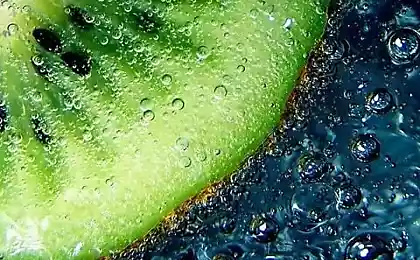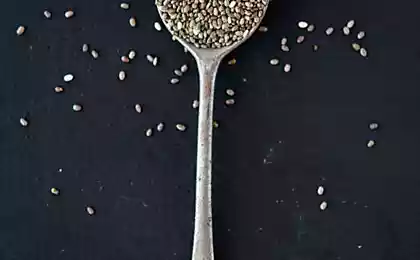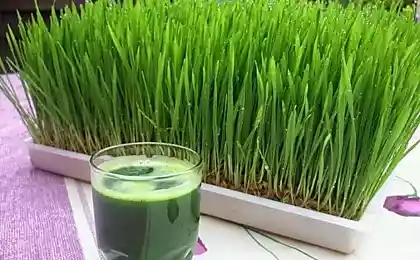540
How to get more fiber into your diet: 5 simple ways
We all know that we need a good dose of fiber every day to improve the metabolism and improve the digestive process, rid our digestive tracts of waste accumulation and reduce inflammation. You can accurately monitor PFC (protein, fat, carbs) and calories in your diet, but it's hard to keep track of more fiber.
The recommended minimum daily intake of fiber is 25 g, but if your digestive system is not okay, and you want to improve, you need to consume more.
Getting more fibre is not as difficult as you think.

When most people think about increasing dietary fiber in the diet, they think that you need to eat more grain. This is a mistake, given the regular deception of producers of bread and bakery products. The problem with these products is that they add a lot of sugar, artificial ingredients, sodium and calories, respectively. This becomes a problem especially for those who need to watch your carbs and / or sugar when trying to lose fat and / or correct problems sensitivity to insulin.
When trying to get 25g of fiber by consuming cereals you can eat too many more carbs and calories. Slice of wholemeal bread contains between 1 - 3G of fiber, around 60-70 calories and 13-20g of carbohydrates. I know that no one try to get all 25g of fiber from bread, but imagine if suddenly it is so, then you would add yourself, at least 600-700 calories a day and tons of carbs.
The good news is that you can get an additional vegetable fiber to your diet, without consuming grains grain, and sometimes, even eating less calories. How to achieve this?
Here are ways to get more fiber in your diet, without adding carbohydrates or calories:
1. Not cleansing the skin with the fruit.
The vast majority of the fibers in fruits and vegetables contained in their skins. The peel also contains a lot of vitamins and antioxidants, especially apples and red grapes. Whenever your diet is planned vegetables and fruit try to cleanse their skin. You get a whopping dose of insoluble fiber, which like a brush or broom to cleanse your digestive tract. The best part is that you don't add calories by eating the peel because it is not digested.
One note: This applies to organic fruits and vegetables. Now many (almost all) manufacturers put very chemistry. Pesticides and herbicides are absorbed through the skin, so even after washing and rubbing, you do not remove all the toxins.
2. Eat more berries.
If you are not a very strict restriction of carbohydrates, you can afford some berries or low GI fruit. With a low glycemic index you of course select berries. Not only are they low GI, but these tiny seeds in strawberries, raspberries and blackberries are nothing like insoluble fiber. In addition, you'll get tons of antioxidants and vitamins, including vitamin C and resveratrol, which boost muscle recovery and the immune system. Berries are also among the most low-calorie fruits that you can eat. Again, please buy organic berries so as not to get a hefty dose of toxins.
3. Focus on the cruciferous vegetables.
Cruciferous vegetables such as broccoli, cauliflower, white cabbage, Chinese cabbage and Brussels sprouts contain more fiber than other vegetables. They are also full of phytonutrients that you can not get from grains, are very low in calories and extremely low on the glycemic index, which is very important if you have reduced intake of carbohydrates or insulin.
Less than thermally treated cabbage, the more dietary fiber it retains. If you cook cabbage, it is better to prepare on pair or a bit of stew, enough to make it a little softer, but still leave fresh. Leave the digestion of your digestive system, so she can do most of the work on the breakdown of the fibers. It will also help to slow down the process of digestion and assimilation of carbohydrates and fats.
Due to the high fiber content in cruciferous vegetables, they are usually very bulky and you can eat many of these vegetables consuming very little calories and having produced a feeling of satiety and satisfaction much longer than to eat spinach or lettuce.
4. Pharmacy fiber.
Though not the best option, as processed fiber, but if products can't get enough – then this option will come to the rescue. The most remarkable pharmacy of fiber in that it does not deteriorate and has a long shelf life, you can take it with you on the road and just to have in reserve. It can be added to protein shake or in juice, can also be added to mashed potatoes, omelettes and other dishes. But do not add too much to your smoothie or juice, they may thicken significantly change the taste. One or two teaspoons of it! This will help satiate your diet in fiber.
5. Add flax seeds to your food.
Flax seeds are full of healthy fats and one tablespoon of flax seeds is placed 84 mg of potassium, 66 mg of phosphorus, 26 mg of calcium and 40 mg of magnesium. One tablespoon also contains 2.8 g of fiber, almost 2 grams of protein and only 55 calories!
You can add them to cereal, salads, stir into soups or add them to your homemade dressings. They give a nice nutty flavor to most foods.
Getting more fiber in your diet should not mean that you will consume more carbs, adding a lot of calories or that you give up other products.

Using these tips consuming more fiber, you will feel more satiated even by consuming a limited number of products.
You will feel the advantages of the consumption of a larger amount of tissue within just a few days. Your digestion will work better. You will relieve your body from waste and toxins digestion will feel lighter, cleaner and more energetic. The level of inflammation reduced. The level of sugar in the blood will also be less, because the high fiber content of the foods will slow the absorption of sugar in the blood. It also means increased level of sensitivity to insulin.
Magic point that helps to reduce excess weight
Renal failure: 8 main symptoms
It is not necessary to use all these tips at once... Just one or two of these tips will have a huge impact on your body. Start with one item and then I will add a few each week to improve health. You won't regret it.published
Source: butakova.info/blog/5-prostyx-sposobov-chtoby-poluchit-bolshe-kletchatki-v-svoyom-racione.html
The recommended minimum daily intake of fiber is 25 g, but if your digestive system is not okay, and you want to improve, you need to consume more.
Getting more fibre is not as difficult as you think.

When most people think about increasing dietary fiber in the diet, they think that you need to eat more grain. This is a mistake, given the regular deception of producers of bread and bakery products. The problem with these products is that they add a lot of sugar, artificial ingredients, sodium and calories, respectively. This becomes a problem especially for those who need to watch your carbs and / or sugar when trying to lose fat and / or correct problems sensitivity to insulin.
When trying to get 25g of fiber by consuming cereals you can eat too many more carbs and calories. Slice of wholemeal bread contains between 1 - 3G of fiber, around 60-70 calories and 13-20g of carbohydrates. I know that no one try to get all 25g of fiber from bread, but imagine if suddenly it is so, then you would add yourself, at least 600-700 calories a day and tons of carbs.
The good news is that you can get an additional vegetable fiber to your diet, without consuming grains grain, and sometimes, even eating less calories. How to achieve this?
Here are ways to get more fiber in your diet, without adding carbohydrates or calories:
1. Not cleansing the skin with the fruit.
The vast majority of the fibers in fruits and vegetables contained in their skins. The peel also contains a lot of vitamins and antioxidants, especially apples and red grapes. Whenever your diet is planned vegetables and fruit try to cleanse their skin. You get a whopping dose of insoluble fiber, which like a brush or broom to cleanse your digestive tract. The best part is that you don't add calories by eating the peel because it is not digested.
One note: This applies to organic fruits and vegetables. Now many (almost all) manufacturers put very chemistry. Pesticides and herbicides are absorbed through the skin, so even after washing and rubbing, you do not remove all the toxins.
2. Eat more berries.
If you are not a very strict restriction of carbohydrates, you can afford some berries or low GI fruit. With a low glycemic index you of course select berries. Not only are they low GI, but these tiny seeds in strawberries, raspberries and blackberries are nothing like insoluble fiber. In addition, you'll get tons of antioxidants and vitamins, including vitamin C and resveratrol, which boost muscle recovery and the immune system. Berries are also among the most low-calorie fruits that you can eat. Again, please buy organic berries so as not to get a hefty dose of toxins.
3. Focus on the cruciferous vegetables.
Cruciferous vegetables such as broccoli, cauliflower, white cabbage, Chinese cabbage and Brussels sprouts contain more fiber than other vegetables. They are also full of phytonutrients that you can not get from grains, are very low in calories and extremely low on the glycemic index, which is very important if you have reduced intake of carbohydrates or insulin.
Less than thermally treated cabbage, the more dietary fiber it retains. If you cook cabbage, it is better to prepare on pair or a bit of stew, enough to make it a little softer, but still leave fresh. Leave the digestion of your digestive system, so she can do most of the work on the breakdown of the fibers. It will also help to slow down the process of digestion and assimilation of carbohydrates and fats.
Due to the high fiber content in cruciferous vegetables, they are usually very bulky and you can eat many of these vegetables consuming very little calories and having produced a feeling of satiety and satisfaction much longer than to eat spinach or lettuce.
4. Pharmacy fiber.
Though not the best option, as processed fiber, but if products can't get enough – then this option will come to the rescue. The most remarkable pharmacy of fiber in that it does not deteriorate and has a long shelf life, you can take it with you on the road and just to have in reserve. It can be added to protein shake or in juice, can also be added to mashed potatoes, omelettes and other dishes. But do not add too much to your smoothie or juice, they may thicken significantly change the taste. One or two teaspoons of it! This will help satiate your diet in fiber.
5. Add flax seeds to your food.
Flax seeds are full of healthy fats and one tablespoon of flax seeds is placed 84 mg of potassium, 66 mg of phosphorus, 26 mg of calcium and 40 mg of magnesium. One tablespoon also contains 2.8 g of fiber, almost 2 grams of protein and only 55 calories!
You can add them to cereal, salads, stir into soups or add them to your homemade dressings. They give a nice nutty flavor to most foods.
Getting more fiber in your diet should not mean that you will consume more carbs, adding a lot of calories or that you give up other products.

Using these tips consuming more fiber, you will feel more satiated even by consuming a limited number of products.
You will feel the advantages of the consumption of a larger amount of tissue within just a few days. Your digestion will work better. You will relieve your body from waste and toxins digestion will feel lighter, cleaner and more energetic. The level of inflammation reduced. The level of sugar in the blood will also be less, because the high fiber content of the foods will slow the absorption of sugar in the blood. It also means increased level of sensitivity to insulin.
Magic point that helps to reduce excess weight
Renal failure: 8 main symptoms
It is not necessary to use all these tips at once... Just one or two of these tips will have a huge impact on your body. Start with one item and then I will add a few each week to improve health. You won't regret it.published
Source: butakova.info/blog/5-prostyx-sposobov-chtoby-poluchit-bolshe-kletchatki-v-svoyom-racione.html























